4 Hydrometer Analysis
Introduction
The particle size distribution of soil containing a significant number of finer particles (silt and clay) cannot be performed by sieve analysis. The hydrometer analysis is a widely used method of obtaining an estimate of the distribution of soil particle sizes from the #200 (0.075 mm) sieve to around 0.001 mm. The data are plotted on a semi-log plot of percent finer versus grain diameters to represent the particle size distribution. Both sieve analysis and hydrometer analysis are required to obtain the complete gradation curve of the coarse and fine fraction of many natural soils.
Practical Application
- Hydrometer analysis is essential for obtaining the complete particle size distribution of such soils. Particle size distribution obtained from sieve analysis may be combined with the data from a hydrometer analysis to produce a complete gradation curve. It is possible to approximate the percentage of silt and clay particles present in the finer portion from the hydrometer analysis.
- Particle size is one of the criteria used to determine whether a soil is suitable for building roads, embankments, dams, etc.
- Information obtained from a particle size analysis can be used to predict soil-water movement if a permeability test is not available.
Objective
The objective of this experiment is:
- To determine the particle size distribution of fine-grained soil (smaller than 0.075 mm diameter grains), using a hydrometer.
Equipment
- Balance
- Mixer (blender)
- Hydrometer (152H model preferably,
- Sedimentation cylinder (1000 mL cylinder)
- Graduated 1000 mL cylinder for control jar
- Dispersing agent [sodium hexametaphosphate (NaPO3) or sodium silicate (NaSiO3)]
- Control cylinder
- Thermometer
- Beaker
- Timing device
Standard Reference
- ASTM D7928: Standard Test Method for Particle-Size Distribution (Gradation) of Fine-Grained Soils Using the Sedimentation (Hydrometer) Analysis
Method
- Place 50 g of fine soil in a beaker, add 125 mL of the dispersing agent (sodium hexametaphosphate [40 g/L] solution) and stir the mixture until the soil is thoroughly wet. Let the soil soak for at least ten minutes.
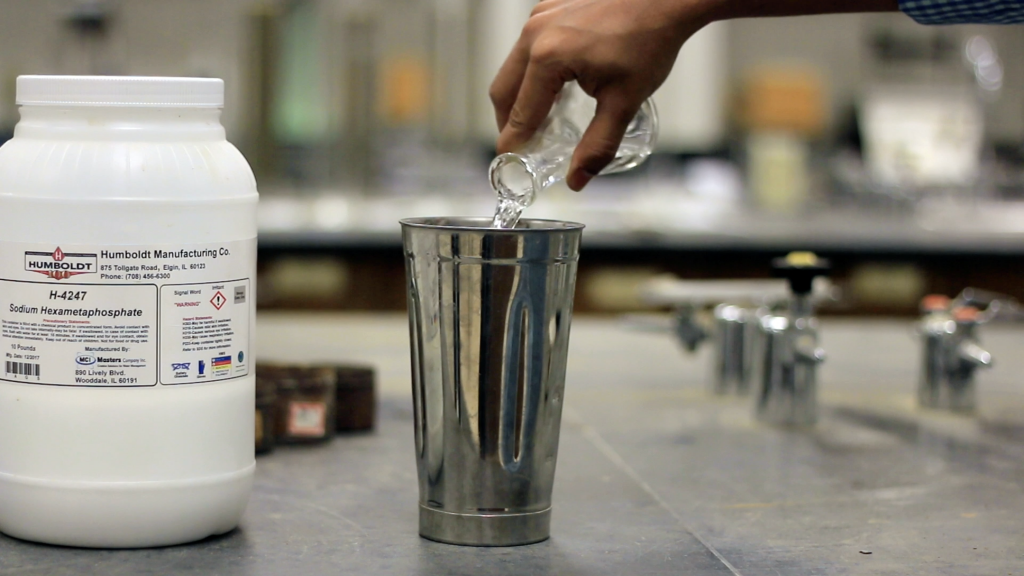
Figure 4.1: Adding sodium hexametaphosphate solution - While the soil is soaking, add 125 mL of the dispersing agent to the control cylinder and fill it to the mark with distilled water. (The reading at the top of the meniscus formed by the hydrometer stem and the control solution is called the zero connection.) Record a reading less than zero as a negative (-) correction and a reading between zero and sixty as a positive (+) correction. The meniscus correction is the difference between the top of the meniscus and the level of the solution in the control jar (usually about +1). Shake the control cylinder to mix the contents thoroughly. Insert the hydrometer and thermometer into the control cylinder and note the zero correction and temperature, respectively.
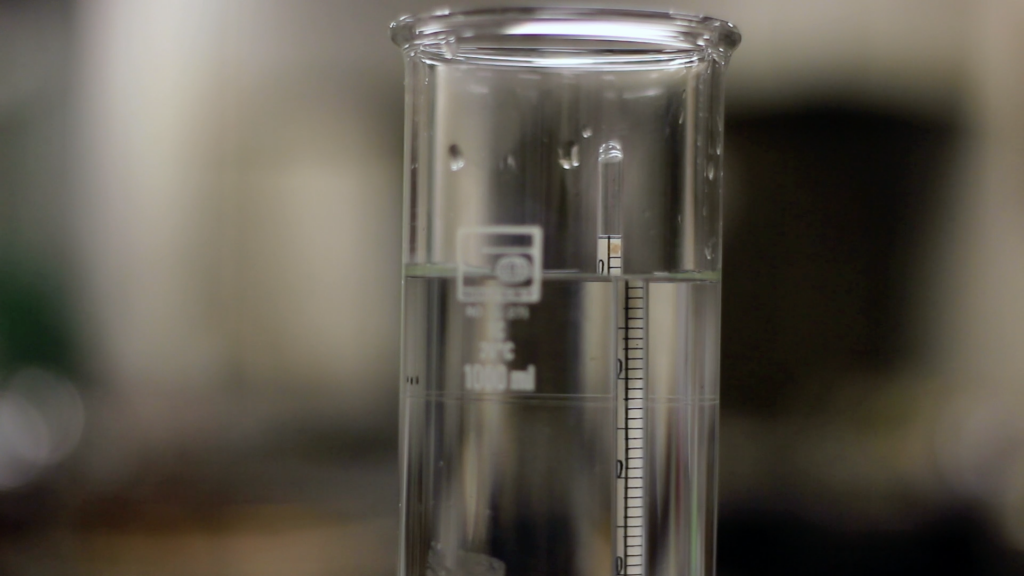
Figure 4.2: Taking zero and meniscuscorrection reading - Transfer the soil slurry to a mixer by adding more distilled water, if necessary, until the mixing cup is at least half full. Then mix the solution for two minutes.
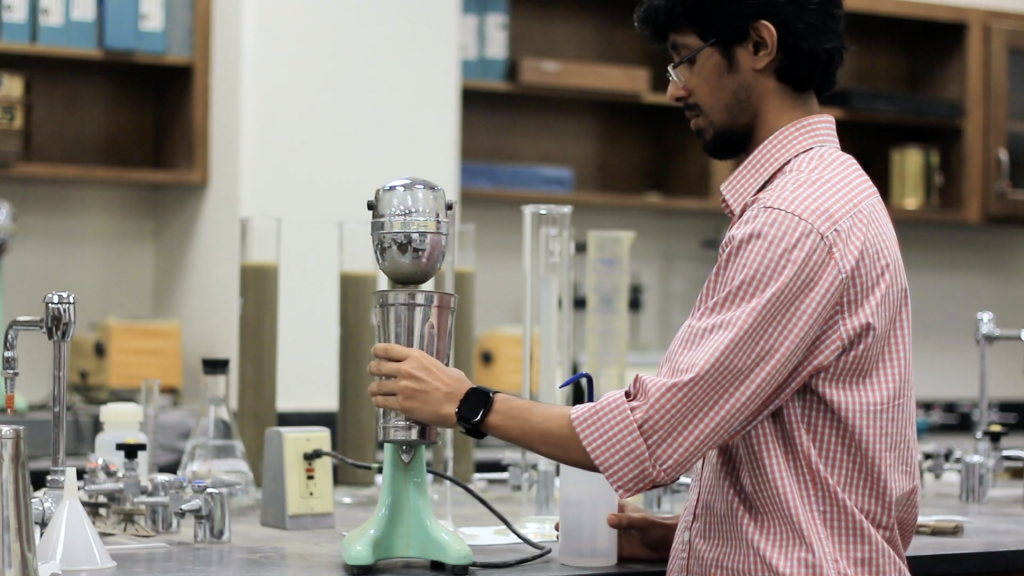
Figure 4.3: Soil slurry preparation using a mixer - Immediately transfer the soil slurry into the empty sedimentation cylinder and add distilled water up to the mark.
- Cover the open end of the cylinder with a stopper and secure it with the palm of your hand. Alternate turning the cylinder upside down and back upright for one minute, inverting it approximately 30 times.
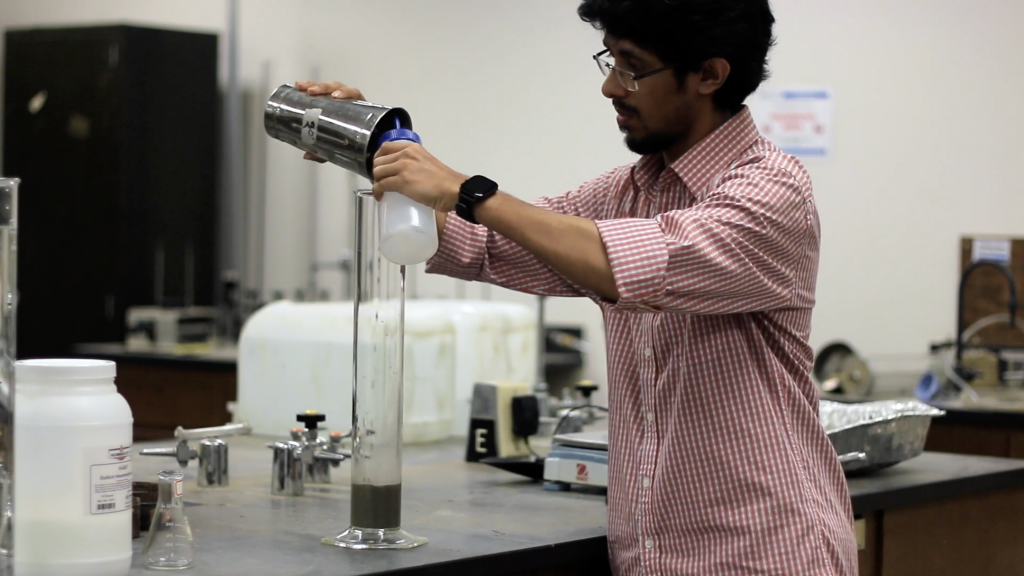
Figure 4.4: Pouring the soil sample into the sedimentation cylinder - Set the cylinder down and record the time. Remove the stopper from the cylinder, and very slowly and carefully insert the hydrometer for the first reading. (Note: It should take about ten seconds to insert or remove the hydrometer to minimize any disturbance, and the release of the hydrometer should be made as close to the reading depth as possible to avoid excessive bobbing.)
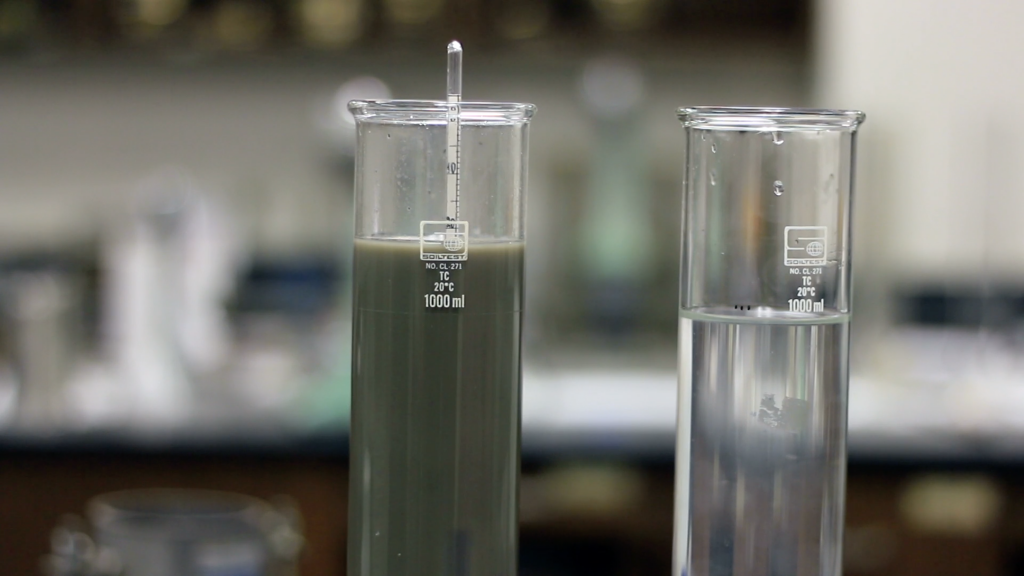
Figure 4.5: Sedimentation cylinder and control cylinder during the hydrometer reading - Take the reading by observing the top of the meniscus that was formed by the suspension and the hydrometer stem. Remove the hydrometer slowly and place it back into the control cylinder. Very gently spin it in the control cylinder to remove any particles that may have adhered to it.
- Take hydrometer readings at 15 sec, 30 sec, 1 min, 2 min, 4 min, 8 min, 15 min, 30 min, 1 hr., 2 hrs., 4 hrs., 8 hrs., 16 hrs., 24 hrs., and 48 hrs. These are approximate times that will usually give a satisfactory plot spread.
- Record the temperature of the soil-water suspension to the nearest 0.5°C for each hydrometer reading.
Data Analysis
- Apply the meniscus correction to the actual hydrometer reading.
- Obtain the effective hydrometer depth (L in cm) for the corrected meniscus reading from Table 4-1.
- Obtain the value of K from Table 4-2 if the Gs of the soil is known. If it is not known, assume that it is 2.65 for this purpose.
- Calculate the equivalent particle diameter by using the following formula:

Where t is given in minutes, and D is given in mm. - Determine the temperature correction CT from Table 4-3.
- Determine correction factor “a” from Table 4-4 using Gs.
- Calculate the corrected hydrometer reading as follows:
Rc=RACTUAL– Zero Correction +CT - Calculate the percent finer as follows:

Where, WS is the weight of the soil sample in grams. - Adjuste the percent fines as follows:

Where, F200= % finer of #200 sieve as a percent
- Plot the grain size curve D versus the adjusted percent finer on the semilogarithmic sheet.
Video Materials
Lecture Video
A PowerPoint presentation is created to understand the background and method of this experiment.
Demonstration Video
A short video is executed to demonstrate the experiment procedure and sample calculation.
Results and Discussions
Sample Data Sheet
Test date: September 15, 2002
Hydrometer Number: 152H
Specific Gravity of Soil: 2.56
% finer of #200 sieve as a percent, F200= 43.9%
Dispersing Agent: Sodium Hexametaphosphate
Weight of Soil Sample: 50.0 gm
Zero Correction: +6
Meniscus Correction: +1
Table 4.1: Values of effective depth based on hydrometer and sedimentation cylinder of specific sizes
For Hydrometer 151H
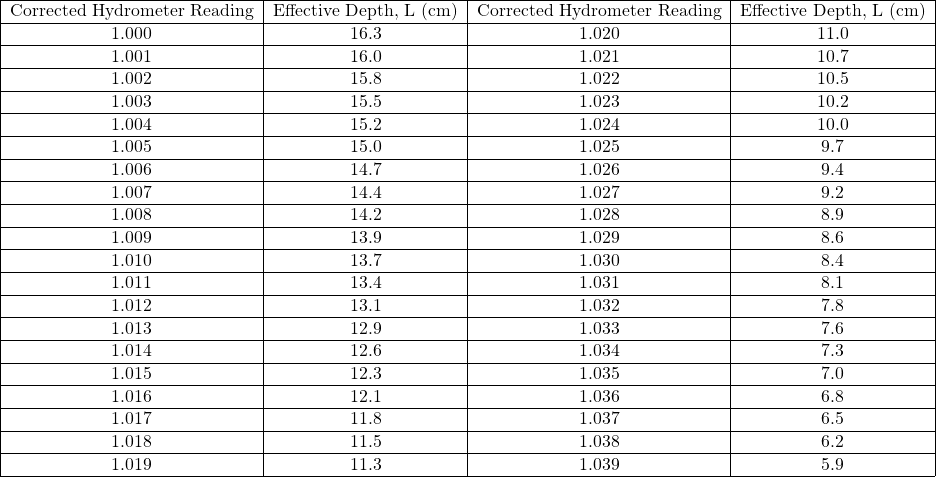

For Hydrometer 152H
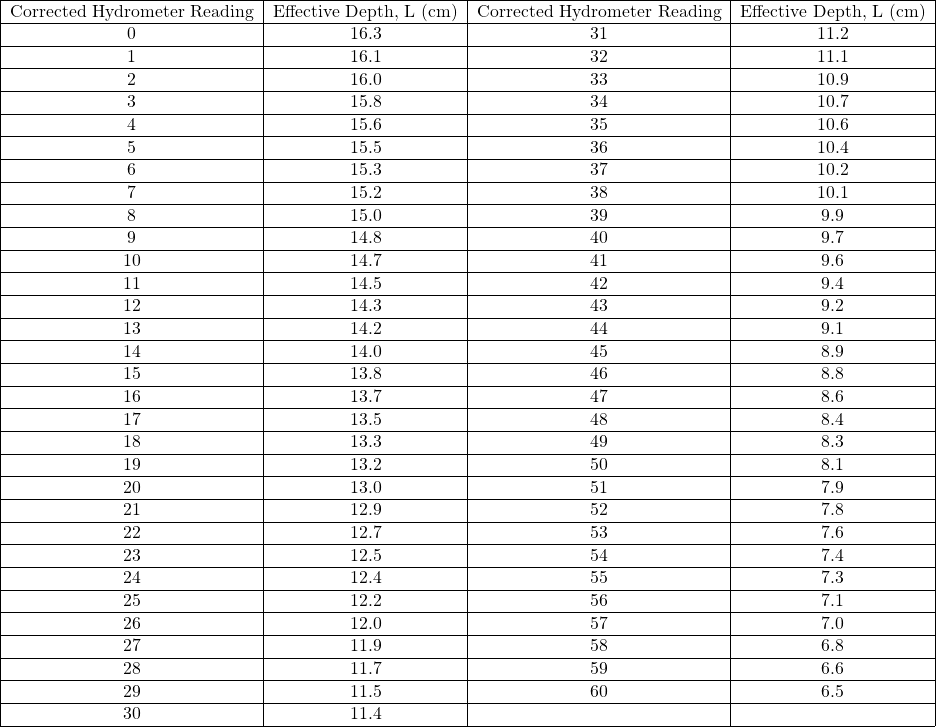

Table 4.2: Values of k for computing diameter of particle in hydrometer analysis
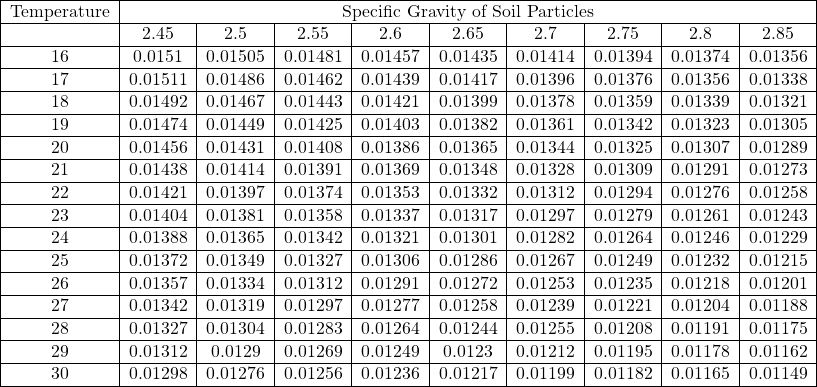

Table 4.3: Temperature correction factors, CT
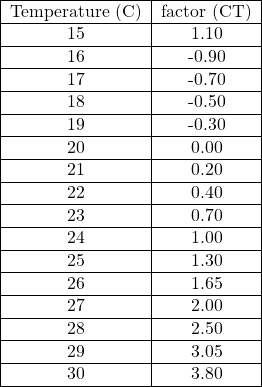
Table 4.4: Correction factors a for unit weight of solids
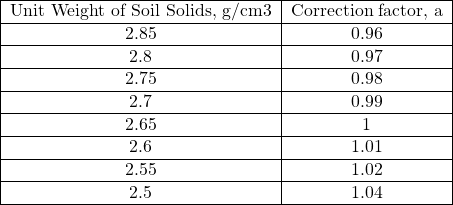
Sample Data Sheet

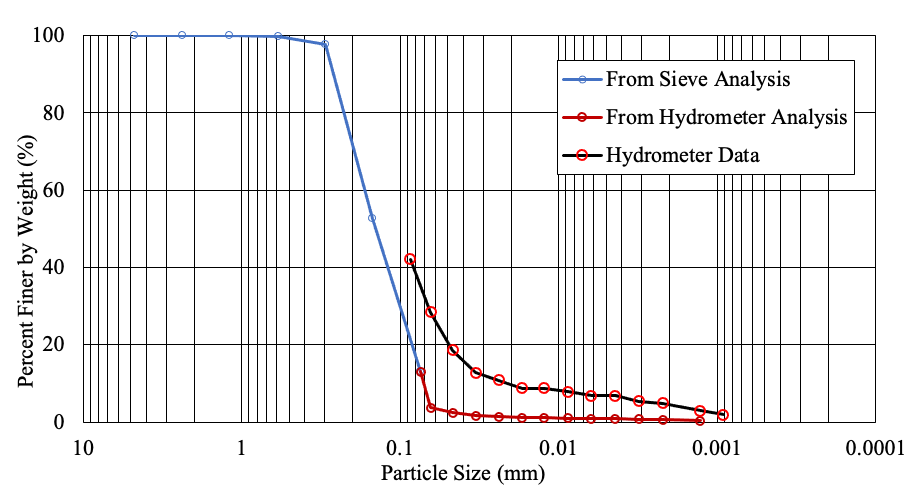
Blank Data Sheet
Test date:
Hydrometer Number:
Specific Gravity of Soil:
% finer of #200 sieve as a percent, F200:
Dispersing Agent:
Weight of Soil Sample:
Zero Correction:
Meniscus Correction:

Report
Use the template provided to prepare your lab report for this experiment. Your report should include the following:
- Objective of the test
- Applications of the test
- Apparatus used
- Test procedures (optional)
- Analysis of the test results – Complete the table provided and show one sample calculation. Draw the grain size distribution curve for the data from the hydrometer analysis only and the combined grain-size distribution curve.
- Summary and conclusions – Comment on the shape of grain size distribution curve of the given soil sample

